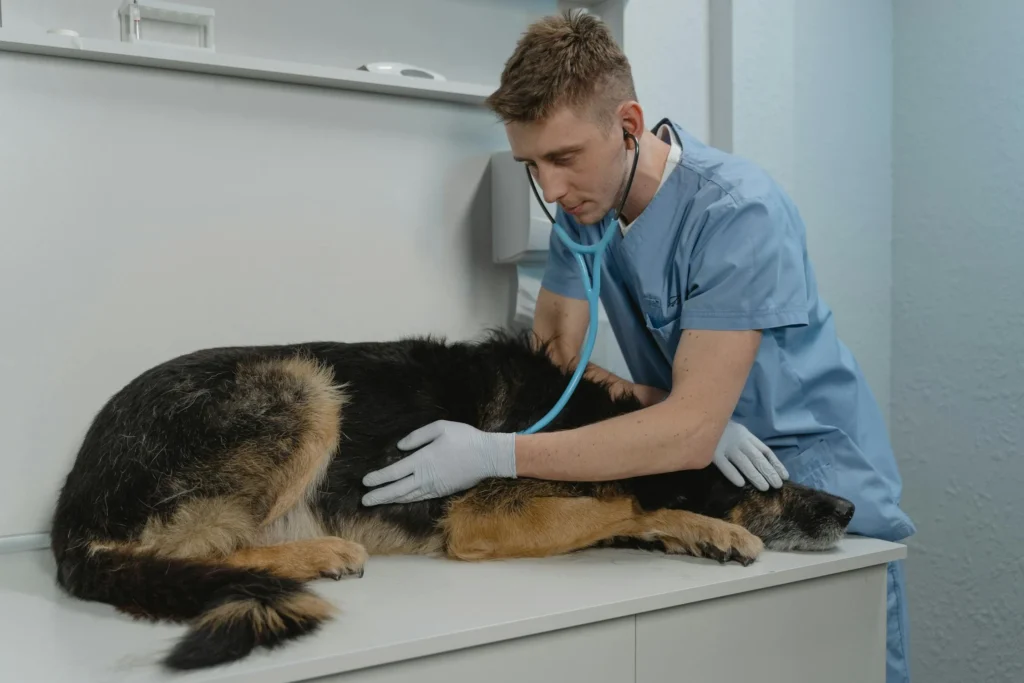Vet-Recommended Guide: How to Fix Paraphimosis in Dogs at Home in 4 Steps 🐶✨

If you’ve landed on this post, chances are you’re dealing with something that’s got you worried: your male dog’s private area looks swollen, red, and maybe even stuck out. You’re probably wondering, “Why is my male dog’s private area swollen and red?” Or more urgently, “How to fix paraphimosis in dogs at home?” First of all, take a deep breath — you’re not alone, and yes, there are steps you can take right at home to help your pup.
This guide walks you through the essentials of paraphimosis in dogs: what it is, how to recognize it, how to fix it at home safely, and when to drop everything and head to the vet. Let’s dig in. 🤖🐕
Table of Contents
What is Paraphimosis in Dogs?
Paraphimosis occurs when a dog’s penis protrudes from the sheath and doesn’t retract naturally. It might seem harmless at first glance, but it can escalate quickly into a medical emergency if not treated.
Why does it happen? It can be triggered by arousal, licking, trauma, or even a hair getting wrapped around the base, restricting blood flow.
Sometimes, this condition is linked to anatomical defects in the prepuce (the sheath), hormonal imbalances, or even behavioral issues that cause excessive licking or mounting. And while it might sound uncommon, it actually happens more often than most dog parents realize, especially in intact males.
If left untreated, the exposed tissue can swell, dry out, or even become necrotic (yikes!). That’s why it’s crucial to act fast, especially when you’re aiming to treat paraphimosis in dogs naturally at home.
Signs of Canine Paraphimosis

Before jumping into treatment, let’s talk symptoms. Spotting these early could save your dog from severe pain and potential surgery:
- Penis visibly stuck outside the sheath for more than a few minutes
- Swelling or redness around the area
- Constant licking or agitation
- Difficulty walking or signs of discomfort
- Penis turning a darker red, purple, or black
- Whimpering, pacing, or hiding
Still wondering, “Why is my male dog’s private area swollen and red?” Well, paraphimosis is often the culprit, especially if your dog seems unusually fixated on the area.
How to Fix Paraphimosis in Dogs at Home: 4 Vet-Recommended Steps
Dr. Ivana Crnec, DVM, and other veterinary pros suggest that mild cases of paraphimosis can be treated at home — with the right tools, gentle hands, and lots of love.
Important Note: If the swelling is severe, or if this is not your dog’s first time dealing with paraphimosis, skip the home treatment and go straight to the vet.
Here’s your home-care roadmap:
Step 1: Stay Calm and Keep Your Dog Calm
Your dog can pick up on your anxiety, and excitement or stress will only worsen the swelling. Gently restrain them in a comfortable position — ideally on their side. Talk softly, give belly rubs, or offer a treat.
If your pup is particularly wriggly, a second pair of hands might help. Wrap your dog in a towel like a burrito, leaving only the area you need exposed. 🥯
Make sure the environment is quiet and free from distractions. Loud noises or stress can make your dog tense up, making the process more difficult.
Step 2: Lubricate the Area
Grab a water-based lubricant (like K-Y Jelly or plain aloe vera gel). Gently apply it around the penis and sheath. This helps reduce friction and prepares the tissue for repositioning.
Avoid anything with menthol, fragrance, or medicated ingredients. Think simple, soothing, and safe.
Natural alternatives include:
- Pure coconut oil (cold-pressed and unrefined)
- Olive oil (in small amounts)
Just make sure your dog doesn’t lick it off too soon! Using an Elizabethan collar can help.
Step 3: Gently Reduce the Swelling
You can use a sugar solution (mix sugar with a small amount of water) or granulated sugar to reduce swelling. This works by osmosis — drawing excess fluid out of the tissue.
Apply the sugar directly to the swollen tissue and wait 5-10 minutes. The swelling should visibly reduce, making it easier to reposition the penis.
Dr. Patty Khuly, a Miami-based veterinarian, supports this technique as a practical first-aid solution.
Some dog parents have also found success using:
- Cold green tea bags (as compresses for mild anti-inflammatory benefits)
- Witch hazel pads (alcohol-free) to reduce irritation
Rinse the area gently after using any of these methods.
Step 4: Manually Reposition the Penis
Once the swelling subsides and the area is lubricated, gently slide the penis back into the sheath using your thumb and forefinger. Be extremely gentle. Do NOT force it.
If it doesn’t go back in with gentle pressure, stop and consult your vet immediately.
After it’s retracted, apply a cold compress to reduce residual swelling and prevent recurrence.
Observe your dog for the next 30-60 minutes. If the penis re-emerges again, you may need a vet visit to assess for anatomical or hormonal causes.
Natural Remedies and Preventive Tips

If you’re curious about how to treat paraphimosis in dogs naturally, here are a few more holistic and preventive tips:
- Trim the Hair Around the Area: Hair can trap debris or even form a tourniquet around the base. Keep it neatly trimmed.
- Monitor Hormonal Surges: Unneutered males are more prone. Neutering often helps prevent recurrent paraphimosis.
- Hydration and Diet: Inflammation is worsened by dehydration. Make sure your dog is drinking enough water and eating anti-inflammatory foods.
- Calendula or Witch Hazel (in small amounts): These herbal remedies can soothe inflammation but consult a vet first to ensure safety.
- Probiotics and Omega-3s: Supporting your dog’s immune system helps prevent infections and reduce inflammation.
- Daily Hygiene Routines: Use a damp cloth to gently wipe the sheath area during bath time or after outdoor play.
When to See a Vet
Not every case of paraphimosis is a DIY project. Seek veterinary attention immediately if:
- Swelling does not improve in 30 minutes
- The penis becomes dark purple or black
- Your dog is in visible pain
- It keeps happening repeatedly
- Your dog can’t urinate properly
- There are open sores or signs of infection
Dr. Jerry Klein, Chief Veterinary Officer at the AKC, stresses the importance of not delaying care in moderate-to-severe cases. Tissue can die quickly if blood flow is cut off for too long.
Treatment at the Vet’s Office

At the vet, your dog might receive:
- Injectable anti-inflammatories
- Sedation for more delicate repositioning
- Sutures or minor surgery if the sheath is too tight
- Antibiotics to prevent infection
- Bloodwork or urinalysis to rule out underlying infections or systemic issues
In chronic or severe cases, your vet may recommend a preputial advancement surgery to permanently fix the issue.
Frequently Asked Questions
Q: Can I prevent paraphimosis completely?
Not always, but keeping your dog well-groomed and neutered reduces the chances significantly.
Q: Is paraphimosis painful for dogs?
Yes. If untreated, it can become extremely painful and even life-threatening.
Q: Can I use Vaseline instead of KY Jelly?
Veterinarians usually prefer water-based lubricants. Vaseline is petroleum-based and harder to clean.
Q: Why does my male dog’s private area keep getting red and swollen?
It might be paraphimosis, but it could also be a sign of infection, irritation, or even a tumor. If it’s happening often, get a vet check-up.
Q: What if my dog won’t let me touch the area?
Stop and call your vet. Trying to force the issue can cause more harm and stress. Sedation might be required.
Q: Is it okay to try treating this at home overnight?
Only if the symptoms just started and your dog isn’t in pain. But if you’re unsure, always call your emergency vet clinic.
Final Thoughts
Knowing how to fix paraphimosis in dogs at home can be a literal lifesaver — but it’s not a replacement for proper veterinary care. Mild cases can often be managed safely at home using lubricant, sugar, and gentle hands. But always watch closely, and don’t hesitate to call your vet.
Whether you’re a new dog parent or a seasoned pup pro, having this knowledge in your toolkit means you’re better prepared to support your furry best friend in moments of discomfort. 🐶️✨
Stay informed, stay calm, and remember: your dog is lucky to have a proactive human like you on their side. 🙏🏼
References:
- Dr. Ivana Crnec, DVM – Veterinary consultant and practicing vet
- Dr. Patty Khuly, VMD – Miami-based veterinarian
- Dr. Jerry Klein, DVM – Chief Veterinary Officer, American Kennel Club (AKC)
